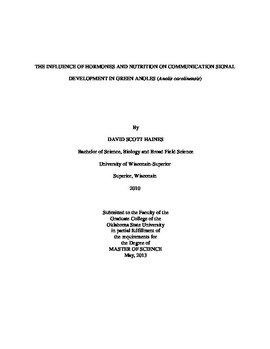| dc.contributor.advisor | Lovern, Matthew B. | |
| dc.contributor.author | Haines, David S. | |
| dc.date.accessioned | 2014-09-24T14:18:02Z | |
| dc.date.available | 2014-09-24T14:18:02Z | |
| dc.date.issued | 2013-05-01 | |
| dc.identifier.uri | https://hdl.handle.net/11244/11088 | |
| dc.description.abstract | Green anoles utilize highly stereotyped species specific displays for both intersexual and intrasexual communication. These displays have garnered much attention from researchers; however, to date no one has conclusively determined if or how anoles assess each other by these displays. Work on avian species, which also utilize stereotyped displays, has revealed that individuals that were exposed to a developmental stress produced lower quality displays. Additionally, testosterone (T) has been shown to either act as a developmental stress when levels are too high, or to mitigate a nutritional stress by either increasing foraging or differentially allocating nutrients. In the current study we assess whether a nutritional stress or treatment with either T or the anti-androgen flutamide (F) will increase or decrease stereotypy. We found that individuals exposed to a nutritional stress displayed with more stereotypy than those fed on a normal diet. Additionally, F treated individuals displayed with more stereotypy than controls while T treated individuals displayed with less stereotypy than either control or F treated individuals. We additionally found that our T treatment caused sub-adults to copulate, which has not previously been observed. Finally, juvenile T treated individuals headbobbed more frequently, but adult T treated individuals headbobbed less than their peers. We conclude from this study that while both the nutritional and hormonal treatment has a causal effect on headbobbing stereotypy, it seems unlikely that anoles use it as a mechanism to evaluate either opponents or mates. | |
| dc.format | application/pdf | |
| dc.language | en_US | |
| dc.publisher | Oklahoma State University | |
| dc.rights | Copyright is held by the author who has granted the Oklahoma State University Library the non-exclusive right to share this material in its institutional repository. Contact Digital Library Services at lib-dls@okstate.edu or 405-744-9161 for the permission policy on the use, reproduction or distribution of this material. | |
| dc.title | Influence of Hormones and Nutrition on Communication Signal Development in Green Anoles (Anolis Carolinensis) | |
| dc.type | text | |
| dc.contributor.committeeMember | Ophir, Alex G. | |
| dc.contributor.committeeMember | Fox, Stanley F. | |
| osu.filename | Haines_okstate_0664M_12745.pdf | |
| osu.accesstype | Open Access | |
| dc.description.department | Zoology | |
| dc.type.genre | Thesis | |
| dc.subject.keywords | anole | |
| dc.subject.keywords | anolis | |
| dc.subject.keywords | behavior | |
| dc.subject.keywords | hormones | |
| dc.subject.keywords | lizard | |
| dc.subject.keywords | nutrition | |
